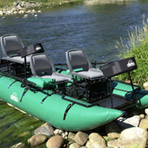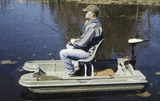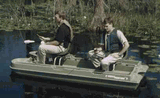Search
Latest Articles
Pontoon Boats for Bass Fishing
by Bruce Middleton, March 29, 2009
When it comes to fishing for bass most anglers think they need a really big and powerful bass boat to go fishing in. But in real life we bass fisherman know that there are a lot of options besides owning a big bass boat and that there are a lot of places a bass boat just can’t get into. Fishing from the back seat of a friends bass boat or the front seat of a friends smoker craft are viable options to fish from verses buying your own. Joining a BASS club can introduce you to a lot of people who would love to take you out and show how to fish. Having a little company while fishing can be very relaxing.
Fishing from the bank or a dock is a good way to start fishing and if you add in waders you can get quite a ways out from the waters edge. There are float tubes too that will take you into places a big bass boat just has no way of getting into along with places like a big lake. Even a canoe is a great option for fishing out of. You just need to remember to stay low in the canoe though, as they can be a bit tipsy. My very first boat was a plywood pram I built. It was eight feet long and lasted me for years and years. My dad finally got rid of it when I went into the Army. I spent many a day out in that boat fishing and it held up very well despite the fact that after the first paint job I didn’t do a thing to it except toss it into the water and fish but it was as good as the first day my dad and I finished it. It took less than three sheets of plywood to build and a little fiberglass, epoxy and some paint was all that was needed. It took us less that a week to build and cost less than a $100 in today’s money. Plans for a pram can be gotten on the Internet.
With all of these options you can get into smaller bodies of water like beaver ponds that don’t have a launch ramp. They can also get you into backwater sloughs where a big boat can’t get to also. But today there are even more options available to anglers that can go into small and big water both that weren’t available even a few years ago. One of these new options are small one, two and three man pontoon boats. These boats are smaller versions of bigger river running pontoon boats that go down rapids on rivers like the Colorado and Snake Rivers. Other styles exist too that don’t come with oars and are especially made to have an electric motor mounted on them for propulsion.
One day last year near the end of the regular season I spotted two really unique pontoon boats out in the water of one of my favorite lakes. They were small one-man pontoon boats with an electric trolling motor mounted on the back. These small craft are ideal for a person on a limited budget or don’t have a big truck to haul a big boat with. The electric motor made the boat as fast as a 5 horse power engine on a 14 foot aluminum smoker craft since so little of the pontoons were in the water and considering how light they are. This was also a great looking small craft that I wish had come out a long time ago so I had the chance to try one out when I was first starting out.
I went on line the other day and entered the key words “one man pontoon boat” and was surprised that over twenty thousand hits came up. I did a short search and came up with the names of at least 10 makers of these pontoon boats and I also found out that they come in one, two and three man sizes. Some were also the huge versions for river running. All of them come with oars and most of them have a cargo platform on the back that a battery and an electric motor can be mounted on. They also had what they called cargo pockets in the front of the boat to hold those items you use a lot like pliers to disgorge hooks, your favorite lures and scent bottles. These pockets were mounted on a bar in front of the angler as well as pockets on the tops of the pontoons themselves. They all had a hard plastic chair or chairs mounted on cross bars that were curved and gave the chair maximum comfort. One had a basket across the back of it that extended all the way to the front of the boat. This is where your feet go and adds lots of space to hold tackle. Pockets were mounted on them and they had trolling motors that were controlled by reaching over your shoulder since the motor was behind the angler. A really classy looking boat too with a bright paint job and lots of chrome. These models didn’t have seats that swiveled but some models did so as to make steering easier. Some models are just two seats on cross bars mounted on two pontoons and weigh in at less than 35 pounds. Very easy to load into the back of a truck or a small trailer built low to the ground.
These small craft are also a very good alternative for going down large rivers like the Columbia where you can put in at one spot and fish down to a haul out area and the load the boat up and go home. Any lake would be open to you too with such a craft. I think one of the real beautiful things about these pontoon boats is the fact that most need no tools to take them apart or put them together. They come with a two-way pump (mounted on the back) to inflate the pontoons with, if you have that style, and it takes about 10 minutes from the time you pull the boat parts out of your rig until you jump in it and start fishing. Really, that isn’t that much slower than it takes to unload a big bass boat. And then park it with the trailer so you can get it out when you’re done fishing. Of course with a truck you wouldn’t have to pump the pontoons up every time and this would make launching one very easy indeed. In fact you wouldn’t even have to dismantle it at all.
The full break down models I looked at weren’t at all complicated and came with very easy to understand instructions. The oars and oarlocks on the models that had them were at a level that made them easy to use without getting in the way or tiring you out as you row along. And like I stated earlier, they accept electric trolling motors quite easily. But you should insure that the maker of the model you choose offer these options. You should also insure that the boat has a cargo platform to hold the battery securely and has a motor mounting bar to tighten the trolling motor to. Access to the trolling motor handle is over your shoulder on those models where the seat doesn’t swivel, so it may take a bit of getting used to as are as which way you turn the handle to go faster or slower. But really I don’t see this as much of a problem at all. On other boats, usually multi-seaters, the seat turned around so the person in the back could control the motor better. Also too the multi-seat models had the front two fisherman seats side by side instead of in a row. I assume this is for balance. Still other models have the motor up front.
The finished weight of these pontoon boats is way under a hundred pounds with most I looked at coming in at around 30 to 45 pounds. The overall size of these boats varies with each maker, as does the size of the pontoons but most seem to buy their pontoons from a single manufacture as they all look about the size and weight and shape. The weight also depends on whether you buy a one, two or three man model since the larger model have to be bigger to accommodate one two or three people. The size is about a little less than the back of a pick-up so they load really easily.
Spare parts, upgrading parts and add on parts are very easy to order and most makers offer some sort of up grade parts so you don’t have to buy one with all the bell and whistles the first time out. About the only thing you can’t do is change a one man to a two-man boat. Now when ordering one of these boats they can run in price from about $185 up to well over a thousand dollars depending on make and model. So a lot of research should be done on your part before buying one. But really this is a real value. Say you spend $400 on a great model. You can’t touch even a used boat for that little money. And the resale value of them also seems quite high which makes it a bargain in any ones book.
Of all the models I looked at I did notice that several models had inflatable pontoons and some had ridged models. That is to say the ridged pontoons didn’t need to be inflated. This makes the size you need to haul around a bit larger than if they we inflatable. The ridged models also added a few more pounds to the overall weight of the boat but that is a personal choice you will have to make if you decide to buy one. The real question to ask your self is, do you mind pumping up the pontoons every now and then or each time you go out or do you not want to worry about that at all. Also you need to realize that blow up pontoons will eventually wear out over time where a solid pontoon will probably last much longer and take a lot more abuse than an inflatable one. By abuse I mean that scrapping them across the concrete boat ramp while landing the boat and pushing off when you are just starting to go fishing. Aah-Boats.com is one great source to look for this style of boat. It isn’t however the type of hard pontoon boat I saw last year, as I am still looking for the maker of that particular boat. I do know that it was bought at Costco but have been unable to track it down. You should do some research to see if you can find these one man boats that are a cross between the inflatable types and the ridged type in a one man size.
Another thing I really like about these boats is the fact that it takes very little trolling motor power to move one of these boats around. However being so light they can be pushed around by the wind on really windy days. A small windsock might be considered if you fish a lot of windy days. It just goes to show you there is no perfect boat of other conveyance that is all around perfect to fish out of. But one consideration you need to look at is the length of the trolling motor shaft you need to go with the boat. It may have to be longer than normal. This is because in order to reach the throttle comfortably it may have to be up over your shoulder at a comfortable height. But if you are not 6-foot three like I am a shorter shaft may be just the ticket for you.
Now to be honest every boat you fish out of has curtain limitations. As far as pontoon boats go, space is probably one of the biggest limiting factors. You are not going out on the water with 15 pre-rigged rods, 8 tackle boxes and 22 bottles of scent. These pontoon boats are pretty much limited as to how much space you have. If you are rowing the boat then there will be more platform space in the back to hold more tackle but you need to see how hard it is to turn around in one while out on the water. You don’t want to end up flipping the boat over trying to get to a new lure or bait in a tackle box behind you. Also too if you are using a trolling motor you again come face to face with the problem of space. Before buying one of these new pontoon boats, you might look really hard at where you can store an extra rod or two, where the tackle box goes so it is easy to get to, doesn’t fall overboard and what else you have for built in pockets and storage while fishing. I would think after looking at quite a few the ones with a bar that spans both pontoons and sets in front of the driver at just below eye level would be a real help. You could put on rod holders to hold extra pre rigged rods and they have pockets to store enough lures and baits so that taking a tackle box may not be needed. Again, every thing depends on what you get with the boat and what extras you can add to it.
With a couple of the single seat models and some of the multi-seat models, they all had a good-sized area to put your feet on. This also served as extra storage space for tackle boxes under the seat if they had a floor, net or if they just had a bar to put your feet on. A lot of thinking went into the design of these small craft and it really shows it. But you should insure that the bottom area like this has sides to it or a way to clip onto the handle of your tackle box so it doesn’t accidentally fall overboard.
Now safety while using one of these small craft is a real must. This is one boat where I would recommend highly that you wear a life preserver all the time. Because these pontoon boats as so light they may be easy to flip over if you get to rambungous while reeling in the big one or a big ski boat gets to close to you while running at full speed. So be safe no matter what size boat you fish in. A point to remember is that you have a 50/50 chance to survive if you are in 50-degree water for 50 minutes before hypothermia kills you.
I was thinking about mounting a depth finder on one of these pontoon boats and came to this conclusion. The transducer has to be mounted on the trolling motor and the monitor can be secured to the cross bar in front of the driver (no matter what size you are in, IE one, two or three man boat). The monitor can also be mounted on the floor of the boat between your feet. Either way you have a depth finder that you can use or need for fishing for bass. You can use the same battery as the trolling motor so only one is needed.
If you go back to the article I wrote about buying your first big bass boat there is a section in it that deals with the care and maintenance of the trolling motor and motor starting batteries. This will be important to read and understand thoroughly. You want to get the most time out of your battery and taking care of it properly is the only way to go about it.
Well there you go, a look at a new and amazing simple and inexpensive way to go fishing anywhere you want to. You can choose the size you want and it won’t break the bank. These boats are available now just in time for the spawn and you also don’t need a full sized truck to haul one around on. Sweet!
Enjoy!
Bruce Middleton
bpmiddleton@peoplepc,com


